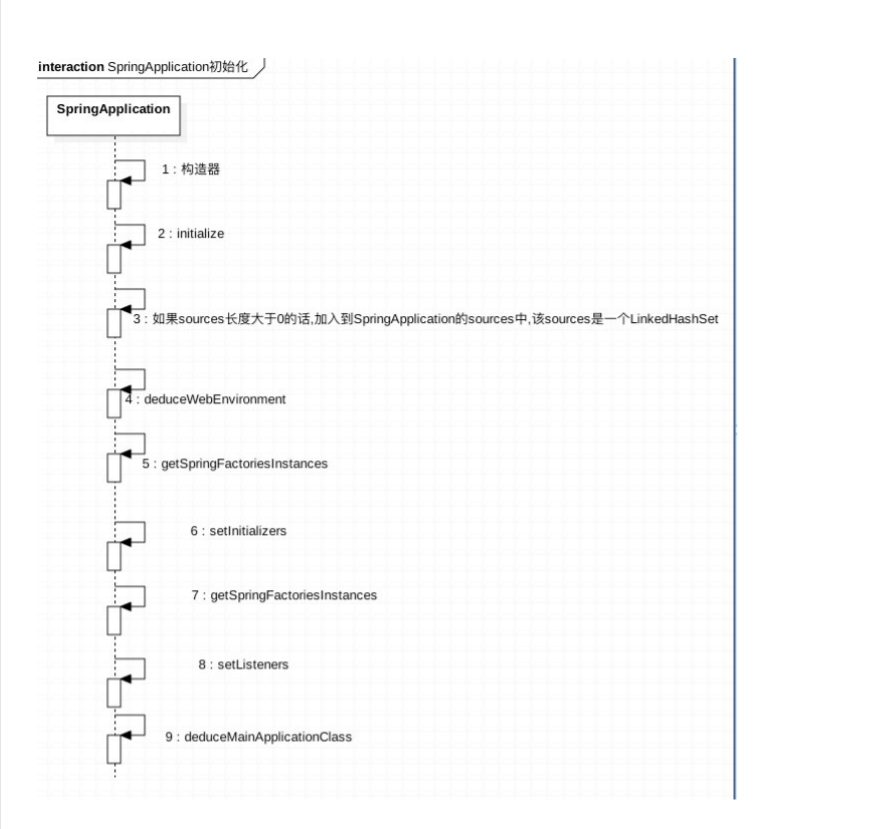前?
我们?成?个spring boot?项?时,会?带?个启动类. 代码如下:
class="java">@SpringBootApplication
public class SpringBootAnalysisApplication {
public static void main(String[] args) {
SpringApplication.run(SpringBootAnalysisApplication.class, args);
}
}
?就是这么简单的代码,构成了spring boot的世界. 那么代码中只有?个@SpringBootApplication 注解 和 调?了SpringApplication#run
?法.那么我们先来解析SpringApplication的run?法.
?
解析
?先调?了org.springframework.boot.SpringApplication#run(Object, String...) ?法.代码如下:
public static ConfigurableApplicationContext run(Object source, String... args) { return run(new Object[] { source }, args); }?
public static ConfigurableApplicationContext run(Object[] sources, String[] args) {
return new SpringApplication(sources).run(args);
}
?可以发现 ?先初始化了SpringApplication,然后调?其实例?法:run.
?
2. 在 SpringApplication 的构造器中,调?了 initialize ?法.
public SpringApplication(Object... sources) {
initialize(sources);
}
?private void initialize(Object[] sources) {
if (sources != null && sources.length > 0) {
this.sources.addAll(Arrays.asList(sources));
}
this.webEnvironment = deduceWebEnvironment();
setInitializers((Collection) getSpringFactoriesInstances(
ApplicationContextInitializer.class));
setListeners((Collection) getSpringFactoriesInstances(ApplicationListener.class));
this.mainApplicationClass = deduceMainApplicationClass();
}
?可以看到做了如下5件事:
1. 如果sources?度?于0的话,加?到SpringApplication的sources中,该sources是?个LinkedHashSet.
2. 调?deduceWebEnvironment?法判断是否是web环境
3. 设置initializers.
4. 设置Listeners.
5. 设置mainApplicationClass.
?
4. deduceWebEnvironment代码如下:
private static final String[] WEB_ENVIRONMENT_CLASSES = { "javax.servlet.Servlet",
"org.springframework.web.context.ConfigurableWebApplicationContext" };
private boolean deduceWebEnvironment() {
for (String className : WEB_ENVIRONMENT_CLASSES) {
if (!ClassUtils.isPresent(className, null)) {
return false;
}
}
return true;
}
?可以发现会调?ClassUtils类的isPresent?法,检查classpath中是否存在javax.servlet.Servlet类和
org.springframework.web.context.ConfigurableWebApplicationContext类,如果存在的话,返回true.否则返回false.
?
5. 在设置Initializers时?先调?getSpringFactoriesInstances?法加载ApplicationContextInitializer.然后直接赋值给initializers.代码如下:
private <T> Collection<? extends T> getSpringFactoriesInstances(Class<T> type) {
return getSpringFactoriesInstances(type, new Class<?>[] {});
}
?private <T> Collection<? extends T> getSpringFactoriesInstances(Class<T> type,
Class<?>[] parameterTypes, Object... args) {
ClassLoader classLoader = Thread.currentThread().getContextClassLoader();
// Use names and ensure unique to protect against duplicates
// 使?Set保存names来避免重复元素
Set<String> names = new LinkedHashSet<String>(
SpringFactoriesLoader.loadFactoryNames(type, classLoader));
// 根据names来进?实例化
List<T> instances = createSpringFactoriesInstances(type, parameterTypes,
classLoader, args, names);
// 对实例进?排序
AnnotationAwareOrderComparator.sort(instances);
return instances;
}
?该?法逻辑如下:
1. ?先获得ClassLoader.
2. 调?SpringFactoriesLoader#loadFactoryNames进?加载,然后放?到LinkedHashSet进?去重.
3. 调?createSpringFactoriesInstances进?初始化
4. 排序
其中SpringFactoriesLoader#loadFactoryNames代码如下:
public static List<String> loadFactoryNames(Class<?> factoryClass, ClassLoader classLoader) {
String factoryClassName = factoryClass.getName();
try {
Enumeration<URL> urls = (classLoader != null ? classLoader.getResources(FACTORIES_RESOURC
E_LOCATION) :
ClassLoader.getSystemResources(FACTORIES_RESOURCE_LOCATION));
List<String> result = new ArrayList<String>();
while (urls.hasMoreElements()) {
URL url = urls.nextElement();
Properties properties = PropertiesLoaderUtils.loadProperties(new UrlResource(url));
String factoryClassNames = properties.getProperty(factoryClassName);
result.addAll(Arrays.asList(StringUtils.commaDelimitedListToStringArray(factoryClassN
ames)));
}
return result;
}
catch (IOException ex) {
throw new IllegalArgumentException("Unable to load [" + factoryClass.getName() +
"] factories from location [" + FACTORIES_RESOURCE_LOCATION + "]", ex);
}
}
?逻辑如下:
1. 获得factoryClassName,对于当前来说factoryClassName =org.springframework.context.ApplicationContextInitializer.
2. 通过传?的classLoader加载META-INF/spring.factories?件.
3. 通过调?PropertiesLoaderUtils#loadProperties将其转为Properties.
4. 获得factoryClassName对应的值进?返回.
对于当前来说,由于我们只加?了spring-boot-starter-web的依赖,因此会加载如下的配置:
1. 在spring-boot/META-INF/spring.factories中.org.springframework.context.ApplicationContextInitializer值如下:
org.springframework.context.ApplicationContextInitializer=\ org.springframework.boot.context.ConfigurationWarningsApplicationContextInitializer,\ org.springframework.boot.context.ContextIdApplicationContextInitializer,\ org.springframework.boot.context.config.DelegatingApplicationContextInitializer,\ org.springframework.boot.context.embedded.ServerPortInfoApplicationContextInitializer?
2. 在spring-boot-autoconfigure/src/main/resources/META-INF/spring.factories
中.org.springframework.context.ApplicationContextInitializer值如下:
org.springframework.context.ApplicationContextInitializer=\ org.springframework.boot.autoconfigure.SharedMetadataReaderFactoryContextInitializer,\ org.springframework.boot.autoconfigure.logging.AutoConfigurationReportLoggingInitializer?
因此会加载6个.
SpringApplication#createSpringFactoriesInstances?法如下:
private <T> List<T> createSpringFactoriesInstances(Class<T> type,
Class<?>[] parameterTypes, ClassLoader classLoader, Object[] args,
Set<String> names) {
List<T> instances = new ArrayList<T>(names.size());
for (String name : names) {
try {
Class<?> instanceClass = ClassUtils.forName(name, classLoader);
Assert.isAssignable(type, instanceClass);
Constructor<?> constructor = instanceClass
.getDeclaredConstructor(parameterTypes);
T instance = (T) BeanUtils.instantiateClass(constructor, args);
instances.add(instance);
}
catch (Throwable ex) {
throw new IllegalArgumentException(
"Cannot instantiate " + type + " : " + name, ex);
}
}
return instances;
}
?逻辑如下:遍历传?的names,也就是之前通过SpringFactoriesLoader加载的类名.通过遍历,依次调?其构造器进?初始化.加?到
instances.然后进?返回.
对于当前场景来说:
ConfigurationWarningsApplicationContextInitializer,DelegatingApplicationContextInitializer,ServerPortInfoApplicationContextInitializer
初始化没有做任何事.
ContextIdApplicationContextInitializer在初始化时.会获得spring boot的应?名.搜索路径如下:
1. spring.application.name
2. vcap.application.name
3. spring.config.name
4. 如果都没有配置的话,返回application.
代码如下:
private static final String NAME_PATTERN = "${spring.application.name:${vcap.application.name:${s
pring.config.name:application}}}";
public ContextIdApplicationContextInitializer() {
this(NAME_PATTERN);
}
public ContextIdApplicationContextInitializer(String name) {
this.name = name;
}
?6. 设置SpringApplication#setListeners时,还是同样的套路.调?getSpringFactoriesInstances加载META-INF/spring.factories中配置
的org.springframework.context.ApplicationListener. 对于当前来说.加载的类如下:
org.springframework.context.ApplicationListener=\ org.springframework.boot.ClearCachesApplicationListener,\ org.springframework.boot.builder.ParentContextCloserApplicationListener,\ org.springframework.boot.context.FileEncodingApplicationListener,\ org.springframework.boot.context.config.AnsiOutputApplicationListener,\ org.springframework.boot.context.config.ConfigFileApplicationListener,\ org.springframework.boot.context.config.DelegatingApplicationListener,\ org.springframework.boot.liquibase.LiquibaseServiceLocatorApplicationListener,\ org.springframework.boot.logging.ClasspathLoggingApplicationListener,\ org.springframework.boot.logging.LoggingApplicationListener?
这些类在构造器中都没有做任何事.
7. 调?SpringApplication#deduceMainApplicationClass?法.获得应?的启动类.该?法通过获取当前?法调?栈,找到main函数的
类.代码如下:
private Class<?> deduceMainApplicationClass() {
try {
StackTraceElement[] stackTrace = new RuntimeException().getStackTrace();
for (StackTraceElement stackTraceElement : stackTrace) {
if ("main".equals(stackTraceElement.getMethodName())) {
return Class.forName(stackTraceElement.getClassName());
}
}
}
catch (ClassNotFoundException ex) {
// Swallow and continue
}
return null;
}
?
 DBAEDA575093D9D0.png" alt="">参考视频教程:Spring Boot源码解析
DBAEDA575093D9D0.png" alt="">参考视频教程:Spring Boot源码解析
?
小程序
?

